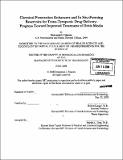| dc.contributor.advisor | Robert Langer. | en_US |
| dc.contributor.author | Simons, Emmanuel John | en_US |
| dc.contributor.other | Harvard University--MIT Division of Health Sciences and Technology. | en_US |
| dc.date.accessioned | 2008-12-11T18:43:06Z | |
| dc.date.available | 2008-12-11T18:43:06Z | |
| dc.date.copyright | 2008 | en_US |
| dc.date.issued | 2008 | en_US |
| dc.identifier.uri | http://hdl.handle.net/1721.1/43872 | |
| dc.description | Thesis (Ph. D.)--Harvard-MIT Division of Health Sciences and Technology, 2008. | en_US |
| dc.description | Includes bibliographical references. | en_US |
| dc.description.abstract | Otitis media (OM) is the most common specifically-treated childhood disease in the United States. The widespread use of systemic antibiotics against a disease of such high incidence is believed to be a driving force behind the observed increase in adaptive resistance among pathogenic bacteria in the nasopharynx. Local, sustained delivery of antimicrobial agents to the site of infection allows for higher drug concentrations and optimized release profiles than are permitted by systemic administration. Higher antimicrobial concentrations sustained for longer periods of time also allow for a faster and more complete eradication of OM bacteria (e.g., H. influenzae, S. pneumoniae), and minimize antibiotic exposure to other bacteria and natural flora in the nasopharynx and upper respiratory tract. We have developed in situ-forming hydrogels to serve as sustained release reservoirs for noninvasive trans-tympanic treatment of OM. A hydrogel that includes potentially synergistic chemical penetration enhancer (CPE) combinations and an antimicrobial sufficiently increases antimicrobial flux such that therapeutic levels can traverse the tympanic membrane (TM) within 12 hours, in vitro. We compare excised chinchilla TMs treated with ciprofloxacin (fluoroquinolone antibiotic) alone and with different combinations of sodium lauryl sulfate, limonene, and bupivacaine, with respect to resultant changes in TM electrical resistance and trans-TM ciprofloxacin flux. We also investigate the interactions of CPEs and local anesthetics with respect to both permeability enhancement and changes in nerve block potency and efficacy. Finally, we evaluate our hydrogel formulations in an in vivo chinchilla model of OM, and demonstrate early success in their ability to safely and effectively eradicate middle ear bacteria. | en_US |
| dc.description.statementofresponsibility | by Emmanuel J. Simons. | en_US |
| dc.format.extent | 135 leaves | en_US |
| dc.language.iso | eng | en_US |
| dc.publisher | Massachusetts Institute of Technology | en_US |
| dc.rights | M.I.T. theses are protected by
copyright. They may be viewed from this source for any purpose, but
reproduction or distribution in any format is prohibited without written
permission. See provided URL for inquiries about permission. | en_US |
| dc.rights.uri | http://dspace.mit.edu/handle/1721.1/7582 | en_US |
| dc.subject | Harvard University--MIT Division of Health Sciences and Technology. | en_US |
| dc.title | Chemical penetration enhancers and in situ-forming reservoirs for trans-tympanic drug delivery : progress toward improved treatment of Otitis media | en_US |
| dc.title.alternative | Chemical penetration enhancers in situ-forming reservoirs for trans-tympanic drug delivery : progress toward improved treatment of Otitis media | en_US |
| dc.type | Thesis | en_US |
| dc.description.degree | Ph.D. | en_US |
| dc.contributor.department | Harvard University--MIT Division of Health Sciences and Technology | |
| dc.identifier.oclc | 263428480 | en_US |
